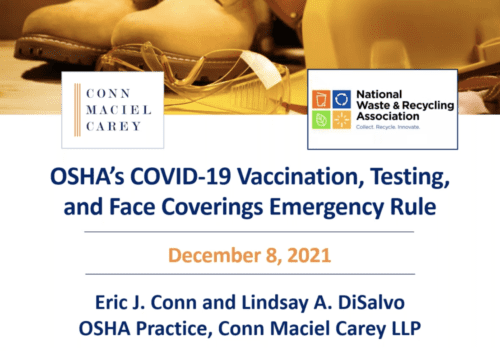Webinar Takeaways: OSHA ETS 101 with Eric Conn of Conn Maciel Carey LLP
The U.S. Department of Labor’s Occupational Safety and Health Administration (OSHA) recently announced a new emergency temporary standard (ETS) to protect more than 84 million workers from the spread of COVID-19 on the job. The ETS announcement sparked mixed reactions, with more than 34 legal challenges initiated by states, individual businesses, religious groups, unions and others.
To take a further look into the ETS and what it means for the waste and recycling industry, the National Waste & Recycling Association (NWRA) held a webinar featuring Eric Conn, founding partner of Conn Maciel Carey LLP and chair of the firm’s national OSHA Workplace Safety Practice Group; Lindsay DiSalvo, associate for Conn Maciel Carey LLP; and Kirk Sander, chief of staff and vice president of safety and standards at NWRA. During the webinar, they discussed the ETS requirements, who is and is not covered by the ETS, the status of the legal challenges to the ETS and more.
The webinar began with a quick overview of the ETS rulemaking timeline pictured below. It’s important to note that this is the second ETS—the first ETS was announced in June, and the mandatory standards of that ETS only applied to the healthcare sector.

The second ETS, announced in early November and applies to more select groups, goes hand in hand with President Joe Biden’s national COVID-19 Action Plan. The six-pronged, comprehensive national strategy aims to combat COVID-19 and features the following components: vaccinate the unvaccinated; further protect the vaccinated; keep schools safely open; increase the testing and mask requirements; protect economic recovery; and improve care for those with COVID-19.
In an effort to decipher the ETS, Conn Maciel Carey LLP has narrowed down the standard to the following core requirements:
- Provide up to four hours of paid time off for employees to get vaccinated. Note that this only applies to the primary vaccinations received during work hours, not the boosters.
- Provide “reasonable” time off and paid sick leave to recover from ill effects of the primary vaccinations.
- Implement a soft-vaccine mandate by which employees may report to the workplace only after demonstrating acceptable proof that they are fully vaccinated such as a COVID-19 vaccination card or opt to provide a weekly negative U.S. Food and Drug Administration-cleared test if they aren’t vaccinated. Note that employers must maintain records of employee COVID testing and determine an effective method to verify the results. If an employee cannot produce “acceptable proof” of vaccination, the employee can self-attest to status in a signed and dated statement.
- Require unvaccinated employees to properly wear a face covering.
- Require employees to provide prompt notice of a positive COVID-19 case and immediately remove them from the workplace until they receive a negative PCR test, they meet the Centers for Disease Control and Prevention’s return to work criteria or their healthcare provider recommends their return to work.
- Prepare a written vaccination, testing and face-covering policy.
- Provide information to employees about the ETS.
- Prepare enhanced reporting requirements for work-related COVID-19 cases.
The ETS covers employers with 100 or more employees companywide, multi-employer worksites with 100 or more employees, independently owned and operated franchises with 100 or more employees and some corporate entities that have multiple entities but operate as a single employer with 100 or more employees. The ETS does not cover workplaces covered by OSHA’s COVID-19 ETS for healthcare, workplaces covered by vaccine mandates for federal contractors, employees who do not report to a workplace where other individuals are present, employees who work from home and employees who work outdoors.
The ETS doesn’t explicitly outline a rule for truck drivers, which was an issue that Conn Maciel Carey LLP’s coalition of employers and trade groups addressed with OSHA, but Conn believes that the mention of isolated workers and outdoor workers addressed the concerns that many industries had about truck drivers.
“By and large, truck drivers have a lower vaccination rate, a higher independent streak, a greater anticipated resistance to vaccination requirements and they are a huge vulnerability to our country right now because of the existing supply chain issues and shortages of drivers,” explained Conn. “… We believe OSHA covered truck drivers without explicitly calling out specific industries [or occupations], and Labor Secretary Marty Walsh mentioned in an interview that the ETS exempts most truck drivers from the rule, which we think endorses the interpretation that we had of the rule.”
So, now that the basic understandings of the ETS are explained, you’re probably wondering about the compliance timeline of the ETS. This is where things get a little more interesting …

The ETS was published in the Federal Register on November 5; however, a day later, the United States Court of Appeals for the Fifth Circuit issued a temporary stay on OSHA’s enforcement of the ETS. Then, on November 12, the circuit ordered OSHA to take no further steps to implement/enforce the ETS until further judicial action is taken. Now, the ball is in the United States Court of Appeals for the Sixth Circuit’s court, which also needs to rule whether to leave the temporary stay in place or replace it with its own temporary restraining order. However, before the Sixth Circuit can issue any substantive rulings, it must decide who will make those rulings. Cases are usually assigned to a three-judge panel, but it could go straight to en banc where it’s heard by the Sixth Circuit rather than the three-judge panel. The Sixth Circuit set a deadline of November 22 for filings related to the temporary stay of the ETS, but it has not yet set a briefing schedule
While we await further action from the Sixth Circuit, covered employers are encouraged to prepare for the ETS to be implemented.
Interested in learning more? Listen to a recording of the webinar here.

